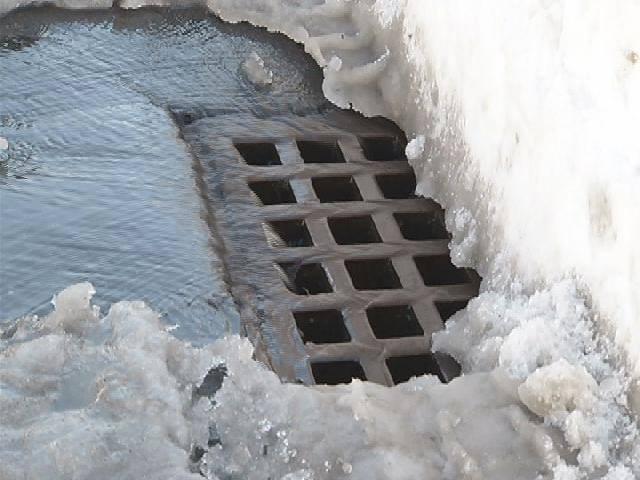
Why do we salt the roads?
Ice forms when the temperature of water drops to 32° Fahrenheit (0° C). Adding salt to the roads lowers the freezing point of the water, which will make it more difficult for the water to freeze. For example, a solution of 10% salt and 90% water will only freeze at 20° Fahrenheit (-6° C), and a 20% salt solution will freeze at 2° Fahrenheit (-16° C). Learn more here.
Road salt serves the critical purpose of keeping roads safe over the winter months, but too much salt can lead to more long-term problems. Learn more about the effects that excess road salt can impact infrastructure, public health, and the local environment below.
The Effects of Excess Road Salt
The majority of drinking water in Anne Arundel County is sourced from underground wells connected to groundwater aquifers (Patapsco, Patuxent, and Aquia aquifers). It is important to do all that we can to ensure that the stormwater feeding these aquifers contains minimal amounts of sodium so that the groundwater can stay as fresh as possible for human consumption.
Drinking water guidelines by the U.S. Environmental Protection Agency (EPA) recommend sodium in drinking water be less than 20 milligrams per liter for those on severely restricted sodium diets.
Sensitivity and irritation to pet paws, toes, feet, and skin can occur from exposure to salt, as well as if the pet eats salt or licks its paws after a walk. Excess salt can cause toxicity concerns and other health problems.
Learn more about tips & tricks for Bay-friendly pet owners on our Pet Waste Reduction Campaign page.
The corrosive nature of salt causes the increased frequency in the need for maintenance, repair, and replacement of pipes, vehicles, bridges, roads, buildings, and other critical infrastructure. Corrosion of water main pipes can lead to an increase in water main breaks and cause discolored water.
Excessive of road salts can cause damage to vegetation, organisms in soil, birds and to other wildlife. Chloride ions from road salts find their way eventually into waterways, either via direct surface runoff or groundwater infiltration. In surface water, excess salt can harm freshwater plants, fish and other organisms that are not adapted to living in saline waters.
Best Practices for Winter Snow Removal
The Bureau of Highways is dedicated to ensuring the safety of the traveling public while providing timely service to our citizens and business communities during inclement weather by planning and executing our winter operation activities on more than 6,700 County-maintained roads and streets. Learn more at the Bureau of Highways Snow Information page.
Are your roads plowed by the County? Access the Snow Level of Service Inquiry here.
When will your roads be cleared? Access the Anne Arundel County Snow Removal Status Map here.
- Shovel early and often - Clear pavement and driveways before snow turns into ice.
- Less is more - Use de-icing products sparingly and evenly. Using a lawn spreader can help with even spreading and prevent clumping. The Wisconsin Salt Wise program offers helpful graphics to demonstrate correct and incorrect salt application.
- Sweep and reuse - Once the snow has melted, you can sweep and collect any remaining salt/sand/de-icer to reuse for the next storm.
- Consider alternative products - Salt-free and pet-safe de-icers, such as those containing calcium magnesium acetate (CMA), are generally more environmentally friendly because it is significantly less corrosive. More information on CMA is available here.
Snow removal professionals play a significant role in ensuring that roads are de-iced in effective and responsible ways across the County. Private salt applicators can learn to balance public safety with environmentally sustainable salt use by learning proper application rates and techniques.
- Montgomery County offers a more extensive list of tips for professional road salt applicators.
- The Wisconsin Salt Wise program offers this Winter Maintenance Salt Application Calculator to estimate the recommended application rate based on the product you use and the temperature range within which it is being used.
- The Snow and Ice Management Association (SIMA) is a trade organization dedicated to offering resources and information for private snow and ice management professionals.
Additional Resources and Programs
- Maryland Salt StoryMap
- Maryland Department of the Environment Winter Salt page
- SHA Salt Management Plan
- Montgomery County Winter Salt Management
- Cary Institute of Ecosystem Studies
- WSSC Salt Wise
- Izaak Walton League’s Winter Salt Watch Program
- Minnesota Smart Salt Training
- Wisconsin Salt Wise Partnership
- Video: Winter Salting Guide by the Wisconsin Sea Grant
- Video: Practice best winter driving practices by AAA
Contact Us
For questions or to inquire about a site visit, please contact our Education and Outreach Coordinator, Sally Albright, via email at pwalbr00@aacounty.org or by phone at (410) 222-0136.


